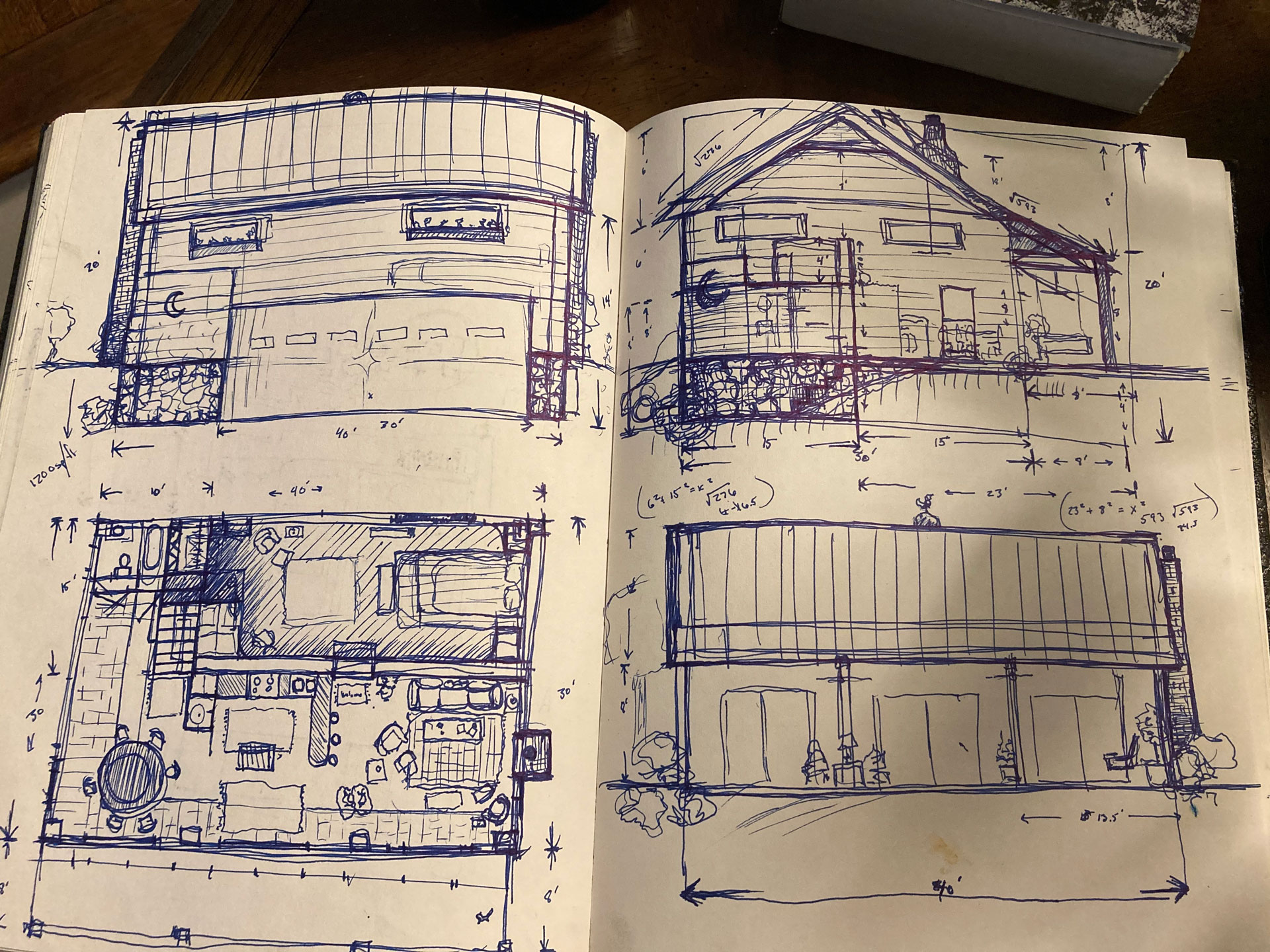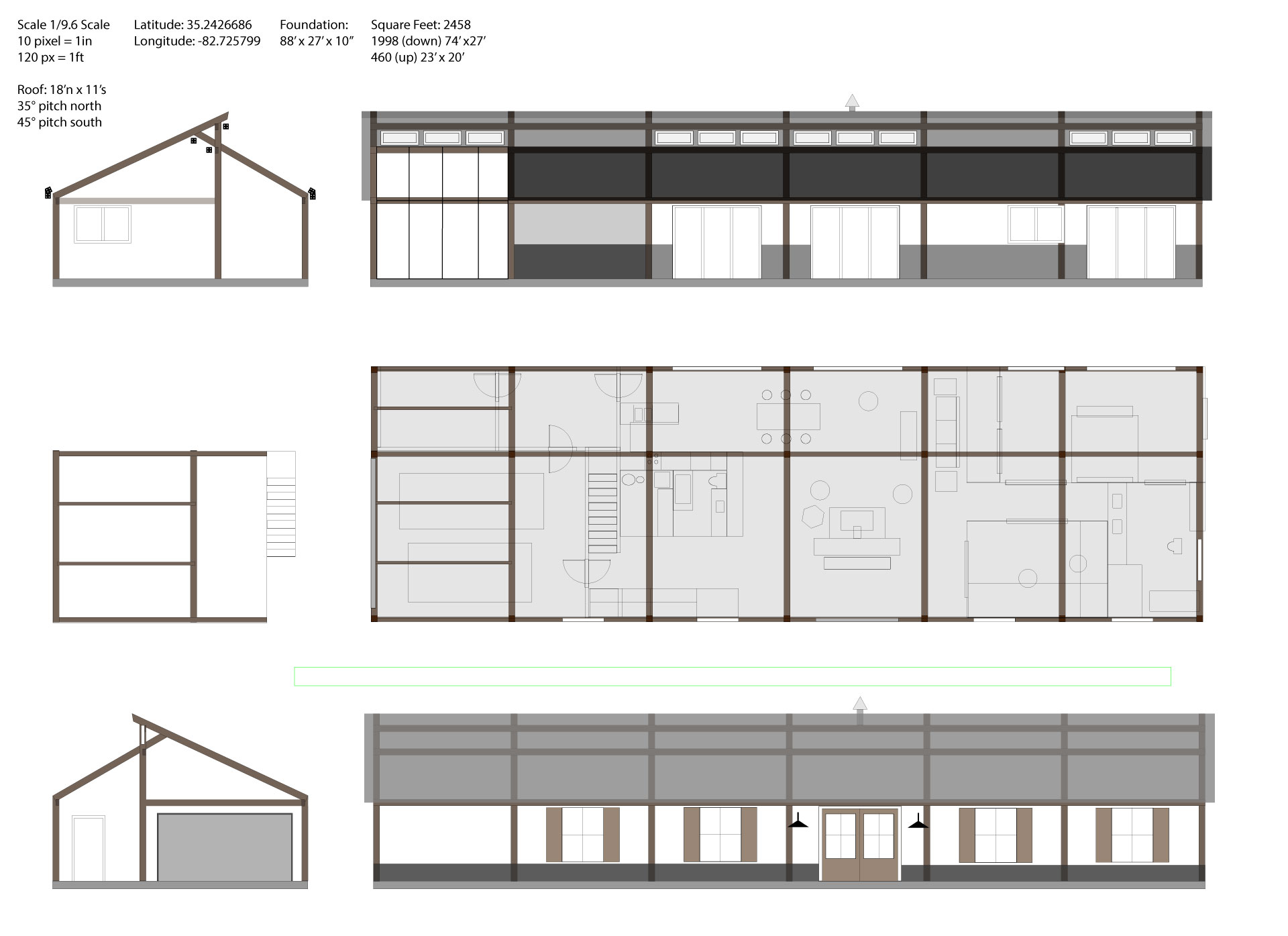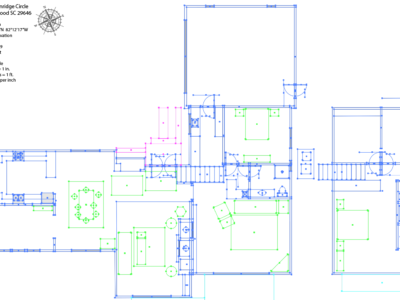Architecture
The image below is a rendering I’ve been working on. It’s done in Illustrator because I don’t have enough experience with other CAD software yet. I’m using a peculiar scale of 1/9.6 so that I can more easily make it pixel perfect. You can click through to see a better scaled image. I’ve always had a fascination with building things. As a kid, I used to talk my mom into buying graph paper at the grocery store because I liked to imagine building things. I think everyone really digs this… don’t they? I think the majority of my early sketches were imaginings of Rube Goldberg1 like things. I remember having a set of strings and pulleys attached in my room which acted like an alarm system if my door was opened. I used to take deconstruct everything including our electronics. I would save the parts like I was going to reuse them for some elaborate machine. I kept that stack of graph paper with me all the time. I would doodle away constantly on random things. I likely made hundreds of home designs. I was particularly fond of when I learned to make perspective drawings and I’m still pretty keen on the using the perspective tools in illustrator and photoshop.

Aside from elaborate ‘forts’ in the woods, I remember the first thing I really set out to construct. It was a 4 foot high skate and bike quarter pipe around 4th grade or so. This wasn’t your average two by twelve and cinder block bike ramp. I spent countless hours designing every detail of the construction. It was tricky too, because the plywood has to curve on a quarter pipe design. My folks insisted that I save the money to buy the materials, so I cut a lot of grass that summer. It turned out pretty nice and it was a hit in the neighborhood. A year later, I bumped that up to an eight foot design mainly for bicycles, but It had a major structural issue. I took the very first run at it on my bike and when nearing the top of the ramp it tipped backward sending me eight feet down to the concrete. I had designed the ramp to go exactly to vertical because the intent was that I want air, but I had failed to provide any stabilization on the back of the ramp. I rigged up some back-stops with two by fours and that ramp was a danger to the neighborhood kids for years to come. I’ve had similar failings like when I built a zip line but used a $4 harness clip and fell about 20 feet out of the trees. I count those as relatively inexpensive learning experiences since I’ve never broke a bone and mostly just minor bruises and stitches.
I briefly considered architecture as a possible major when I first left for college, but I was bit more consumed at the time with art. I was probably more enthusiastic about the idea of being an artist. Likely, just anything to rebel against and find my own way. I started college at an art school who happened to have a decent architectural program but I never pursued it. At the time, I was really into photography, drawing, and painting. I switched colleges and changed my major to mathematics. I switched it back to art because I really got along well with the dean and enjoyed his dixieland jazz band. I apprenticed furniture making for several years during that time and I really enjoyed it. I’ve gradually been building up my tool chest and I keep threatening to my wife that I’m building her next desk or the cabinetry in the walk in closet. I’ve explained to her that I helped build a custom birds-eye maple desk and office cabinetry set for Harriot3 and James Rigney, who is better known as the fantasy author Robert Jordon4. I was just the apprentice and I’m pretty sure any work I might do now would be quite a process of relearning and failing.

The dimensions are too small but it’d make a great garage house or cottage.
And I still like the moon shaped bathroom window looking like an outhouse.
It’s just something I enjoy about the process of creation. I used to use the term Demiurgic5 Design when I first got started. I dropped the moniker some time ago because I think it sounded snotty and erudite. In some ways, my career now is exactly the same, it’s just that the medium is different… computer languages and databases6. I still like to think of projects in the same architectural terms. I like to draft it all out on paper before I start a project. I like to draft out the database schema and information architecture. I remember standing in front of a whiteboard one time explaining a bit of software to a team for a project and imagining the graph paper up on the board. Software and web development are very much like architecture, and engineering. They just lack the tactile results. I’ve found that if I’m struggling with a project in front of the computers, the best thing to do is take a break with something physical where I can see tactile results… like mowing the yard. I think the key to really good programming and database design is in the structure and underlying architecture just like physical structures.
Anyway, I’ve been consuming all of the architecture and home building materials I can get my hands on over the last couple years. I actually sent an email out not too long ago volunteering my time to an architect as a trade-out for learning. I’ve spent a pretty good deal of time studying real estate and was licensed for about six years in multiple regional associations for a related business I owned. I still regularly bookmark properties and homes7. I’ve got a new dream now that, in many ways, is the same childish dream of building forts and bike ramps except this time, it is full scale, costs a lot of money, and takes a lot of time. I’ve had four houses now. The first of which was built by and architect and historic preservationist. It was tiny and had eighteen foot barrel vaulted ceilings. It had geothermal heating and cooling. It was a piece of work. I lived in a small farm cottage built at the turn of the century that had original hand sewn floors, joist, and siding for several years. The next house was a generic brick ranch design in suburban neighborhood and the current home is a modern craftsman8. It’s the rendering up above. It was built in 1979 and the builder is unable to locate the original renderings, so I’ve just been recreating them as I’ve been documenting the other work to the house9. Living in multiple houses is a good way to determine what you like and what you don’t. We’ve taken on gradually bigger projects for each home. I’ve done a bit of work on each of these homes and my confidence is now building beyond my means.
It was only a matter of time before I started designing a couple concept homes. I’d now like to build one. I think it’ll likely take me about ten years to complete. I’m not so foolish to think I could physically built every part of it, but I’ll go so far as to get my general contractors license so that I can sub the work. It’ll be fun studying to pass that test. And although my recent contractors might have labeled me a ‘know it all’, I do want to get my hands dirty because I understand the value of experience. Aside from the design, perhaps I’ll do some of the cabinetry and interior woodwork. I know enough to know when I need help. I’d like to be on site for every step of the process. I’m pretty fixed on the operation of the home and I want a central mechanical room10 to house the heat/air, water/filtration, and electrical. I had watched this episode of This Old House11 where they were touring mechanical rooms in Germany. I do not want a build on grade with a crawlspace or basement and I think the site prep will end up costing a pretty penny to level it out appropriately. I want to custom mill the trees removed from the property and save any rock for landscaping. I want the garden and greenhouse closely integrated into the house. Site selection is tricky because we want several acres close to town and we want an unencumbered south facing layout to maximize the solar collection. I do not want a large landscape to take care of and I want to home to appear modest and visually disappear into the landscape. I’d like to use very standardized sized components so that they are relatively cost efficient and can be replaced. I think I got that from the concept of Shinto shrines12 in an art history class and my furniture maker instructor had built Shinto Torris in his studio. I’ll go high tech, but not in the cameras and automation everywhere sort of way. I’ve designed it so the solar panels track the sun position and I’d like to put in an underground water tank to collect rain water to integrate with an aquaponics13 setup. I don’t want any unused space… two bed, two bath, and an office. My preliminary designs are focused on the build process being a timber frame pole construction14, the location, simplicity, sustainability, energy efficiency, universal design (age in place)15, minimalism, and modernism. Here’s a rendering of one of the concepts:

I’ll eventually start a project page for it. I’m sure lots of folks have this same sort of dream. I remember going to visit a former neighbor of mine who was living in a basement of an unconstructed house in a rural location. At the time it seemed a bit rough, but they now have a multi-million dollar home fifteen years later and he managed to do so as in a relatively blue collar gig working for the forestry commission. I’d imagine that the foremost obstacle to most is money, careers, life balance, etc. I’ve got a plan there too regarding a method to reduce the associated risks by creating a company to do the construction and then selling the house to ourselves when it’s complete. Of course I’m still several hundred thousand shy of where I need to be financially, but aren’t we all. I really don’t think that will stop me and I’ll find a way to make that happen. I really don’t want to pay an exorbitant amount of property taxes either so I want downplay the typical square footage appraisal in lieu of high quality construction, mechanical, and finishes. All kinds of tricky territory and lots of stuff to learn. I’m up for it and I think I’ve about convinced my better half to get on board for the challenge. I suppose you could say that we all are the architects of our own lives in that regard.
- Rube Goldberg – https://en.wikipedia.org/wiki/Rube_Goldberg
- Quarter Pipe – https://en.wikipedia.org/wiki/Half-pipe
- Harriot Rigney – https://en.wikipedia.org/wiki/Harriet_McDougal
- Robert Jordan – https://en.wikipedia.org/wiki/Robert_Jordan
- Demiurge – https://en.wikipedia.org/wiki/Demiurge
- Software Architecture – https://en.wikipedia.org/wiki/Software_architecture
- Bookmarks – https://davidawindham.com/bookmarks/
- American Craftsman – https://en.wikipedia.org/wiki/American_Craftsman
- Glenridge – https://davidawindham.com/wha/glenridge/
- Mechanical Room – https://en.wikipedia.org/wiki/Mechanical_room
- What Germany Can Teach Us About Home Energy | Ask This Old House – https://www.youtube.com/watch?v=wtDbfV5dsNs
- Shinto Shrines – https://en.wikipedia.org/wiki/Shinto_shrine
- Aquaponics – https://en.wikipedia.org/wiki/Aquaponics
- Timber Frame – https://en.wikipedia.org/wiki/Timber_framing
- Universal Design – https://en.wikipedia.org/wiki/Universal_design
23/08/20 – Update – I finally started a dedicated project page @ https://davidawindham.com/til/notes/house/build/ and while doing so I found an early draft image I added to this post. The reason I’m revisiting it is because we’re going to be looking at some property in a couple weeks which got me to thinking about it.
